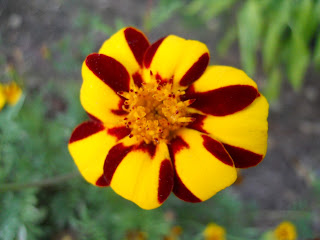On a recent trip to Belize we took an excursion to the ancient Mayan city of Caracol. It is located so deep in the jungle that it takes 4 hours of driving and a military escort to get there. Among the amazing things we saw and learned there was the richness of jungle soil. The site is still being excavated, and one reason for that is the size of the ancient city, but the other reason is that at this point the jungle reclaims the city nearly as fast as it can be uncovered. Fences erected from twigs and branches grow roots and become jungle instead of fence. Avocado trees grow in the middle of plazas that have been clear cut to show how the city functioned in its time. The soil is so rich, you would be crazy to ever think about tilling it, whatever falls on the ground will sprout and grow. Soil like that should be the goal of every gardener; rich, diverse, full of nutrients and life.
When we started our garden in the city, we took over a small plot of land that has been taken care of somewhat. Our downstairs neighbor put a layer of newspaper down under the pavers to prevent weeds from growing. He just finished putting on a layer of top soil from the hardware store, and a layer of mulch on top of that, and there were a few flowers in the ground, and a few herbs in the pots. The condition of the soil was this: it was backfill from construction of the house sometime in the 1910’s, I pulled up many big rocks, cement chunks, plastics, and rebar from the ground (don’t know when and how those got there).
Step one is to get the soil tested. Depending on where you live, there are agencies or universities that do this. Oftentimes at a little cost which is completely worth it. Once you know that the soil is safe, and what it lacks you can go about treating it, and adding necessary nutrients, minerals, and fertilizers. Healthy soil is about balance. It needs to have the right balance of organic and inorganic matter, the right balance of nutrients, acidity, living creatures, etc. But you don’t need to be a scientist or learn chemistry; all you need to do is experiment and grow.
For example, if your soil needs more organic material, composting might be a good way to add some. We don’t compost with worms, although it’s really easy, can be done indoors, and provides a nutrient rich “product” that you can spray in your garden to replace some of the nutrients lost during the growing season. We have friends that do this, and they are kind enough to share.
Another way is to mulch. We usually mulch in the fall, this way the mulch doubles as a blanket for the soil in the winter, and has time to decompose and become one with the soil. This year a tree came down across the street, and the workers were kind enough to give us a few bins of wood chips from the back of the chipper. That was as local as it gets.
 |
| We used to look at this tree from our windows, we still do. |
If you need to introduce more calcium, use egg shells, phosphorus, add a bit of chicken manure. If your soil doesn’t have any critters, you can buy worms. They are sold in most gardening catalogues (they come in little spheres that contain 10 or so eggs, which will grow into worms) and will tell you exactly how healthy your soil is. If they live and prosper, you’re doing something right, if not, keep working.
 |
| Late season radishes. |
This is a good start.
Test your soil.
Start composting (either in a bin or with worms).
Mulch.
Use organic fertilizers. Never use chemicals, herbicides, or pesticides, as those kill everything, mostly things that are useful.
Rotate your crops.
Let’s hope we’re on our way to the unattainable goal of jungle soil.






No comments:
Post a Comment